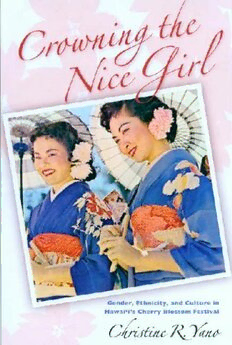
Crowning the Nice Girl: Gender, Ethnicity, and Culture in Hawai'i's Cherry Blossom Festical PDF
305 Pages·2006·6.817 MB·English
Most books are stored in the elastic cloud where traffic is expensive. For this reason, we have a limit on daily download.
Preview Crowning the Nice Girl: Gender, Ethnicity, and Culture in Hawai'i's Cherry Blossom Festical
Description:
After World War II, Japanese Americans in Hawai‘i sought to carve a positive niche of public citizenship in the community. In 1953 members of the Honolulu Japanese Junior Chamber of Commerce and their wives created a beauty contest, the Cherry Blossom Festival (CBF) Queen Pageant, which quickly became an annual spectacle for the growing urban population of Honolulu. Crowning the Nice Girl analyzes the pageant through its decades of development to the present within multiple frameworks of gender, class, and race/ethnicity. Drawing on extensive archival research; interviews with CBF queens, contestants, and organizers; and participant observation in the Fiftieth Annual Festival as a volunteer, Christine Yano paints a complex portrait of not only a beauty pageant, but also a community.The study begins with the subject of beauty pageants in general and Asian American beauty pageants in particular, interrogating the issues they raise, embedding them within their histories, and examining them as part of a global culture that has taken its model from the Miss America contest. Chapter Two weaves a complex picture of the specific historical and contemporary contexts of the CBF Queen Pageant in its infancy by approaching the pageant from different perspectives, including that of its organizer, the Honolulu Japanese Junior Chamber of Commerce. Chapter Three examines the early development of the CBF in the 1950s and 1960s, its glory years. Yano pays close attention to the place of the CBF in light of internal divisions within the Japanese American community, interethnic relations in Hawai‘i, tourism, Nikkei communities in the continental United States, and relations with Japan. She follows the pageant throughout the decades into the 1990s, adding corresponding "herstories"—extensive narratives drawn from interviews with CBF queens. Each narrative is preceded by a commentary that points up the themes of the interview and the changing place of Japanese American women and the CBF in terms of race/ethnicity, gender, and identity. The work concludes by framing issues of race, ethnicity, spectacle, and community within the intertwined themes of niceness and banality.In tying the Cherry Blossom Festival Queen Pageant to images of community, Crowning the Nice Girl demonstrates the ways in which public events such as festivals and beauty contests are central to performances of identity, culture, social class, and politics. It will be of special interest to students and scholars working in anthropology, sociology, history, ethnic studies, and women’s studies.
See more
The list of books you might like
Most books are stored in the elastic cloud where traffic is expensive. For this reason, we have a limit on daily download.
